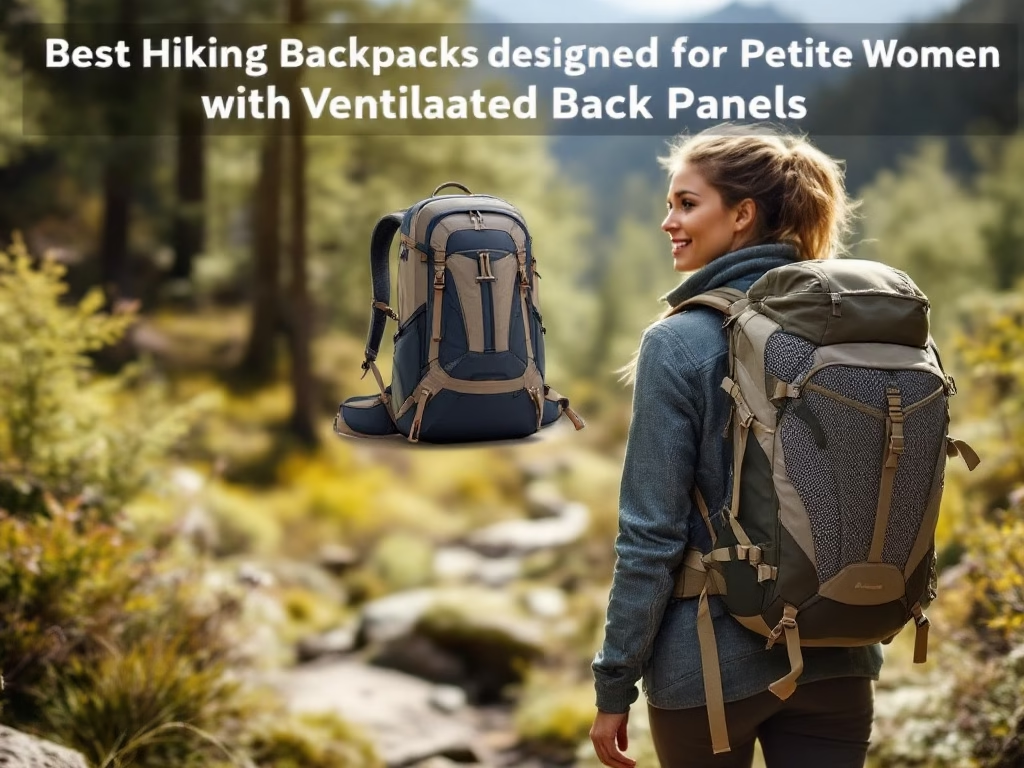Best Petite Hiking Backpacks With Ventilated Back Panels

Looking for the best petite hiking backpacks with ventilated back panels? You’re in the right spot. In this review, you’ll find seven top packs that combine size-friendly fits with airflow-boosting designs. By the end, you’ll know exactly which pack keeps you cool on the trail.
Here’s a peek at what you’ll learn:
- How to dial in fit, capacity, and suspension for shorter torsos
- Key ventilation features that prevent sweaty backs
- Detailed reviews of seven petite-friendly backpacks
Choosing The Right Pack
Picking a new backpack isn’t just about color or brand. You want a pack that hugs your frame, keeps weight close, and vents heat away.
Fit And Sizing
A proper fit starts with measuring your torso. If you haven’t yet, follow our guide on how to measure torso length for hiking packs when you’re petite. Women-specific packs often cater to shorter torsos and narrower shoulders—learn why in why women-specific hiking packs often fit petite frames better.
Capacity And Weight
Day hikes usually call for 20–30 liters, while overnight trips need 35–50 liters. If you’re unsure what size you need, check out how to choose the right capacity backpack for petite day hikes. Lighter packs mean less strain, but don’t skimp on pockets you actually use.
Suspension And Ventilation
A solid suspension system keeps the load stable and close to your back. Look for tensioned-mesh or trampoline-style back panels that create airflow channels. For more on keeping cool in humid conditions, read backpack ventilation solutions for petite women on hot trails and explore best frame types for hiking backpacks that fit petite women.
Key Ventilation Features
Ever been frustrated mid-hike when your back feels like a sauna? Good ventilation can change that.
- Suspended Mesh Panel: A gap between pack and back lets air circulate freely.
- Tensioned-Mesh Frame: Stretchy mesh hugs your torso while keeping the pack off your skin.
- Ventilation Channels: Molded foam or plastic rails guide airflow under the pack.
- Breathable Straps And Hipbelt: Foam with perforations reduces heat buildup on contact points.
- Adjustable Gap: Load-lifters and frame tension allow you to fine-tune how far the pack floats.
These features work together to move sweat away and cool your core, especially on steamy summer hikes.
Top Petite Ventilated Packs
We put seven packs through their paces—assessing fit, airflow, comfort, and features. Here’s how they stack up.
Gregory Jade 38 (Women’s XS)
Capacity: 36 L
Weight: 3.3 lb
Torso Fit: 14–16 in
Rating: 4.5/5
Why You’ll Love It
- Built-in rain cover tucks away neatly
- Front-panel access avoids top-load hassle
- Generous hipbelt pockets for snacks and tools
What To Note
- Not carry-on compliant for most airlines
- Minimal frame adjustability
Best For: Day-long trail runs where airflow and quick access matter
Gregory Deva 60 (Women’s XS)
Capacity: 58 L
Weight: 4.1 lb
Torso Fit: 14–16 in
Rating: 4/5
Why You’ll Love It
- Robust mesh backpanel for steady airflow
- Padded hipbelt balances heavier loads
- Multiple external pockets for organization
What To Note
- Slightly large if you only do weekend hikes
- Extra volume can tempt you to overpack
Best For: Petite backpackers tackling multiday trips
Osprey Exos 58 / Eja 58
Capacity: 58 L
Weight: 3.1 lb
Torso Fit: 15–19 in (adjustable)
Rating: 4.3/5
Why You’ll Love It
- Ultra-light tensioned-mesh frame floats off your back
- Proven anti-gravity suspension vents heat from shoulder to hip
- Removable top lid slims volume on faster outings
What To Note
- Less padding may feel thin for heavier loads
- Hipbelt pockets are roomy but lightly cushioned
Best For: Thru-hikers wanting a balance of ventilation and weight savings
Osprey Atmos AG 65 / Aura AG 65
Capacity: 65 L
Weight: 4.9 lb
Torso Fit: 15–20 in (adjustable)
Rating: 4.6/5
Why You’ll Love It
- Anti-Gravity suspension molds around your body for seamless airflow
- Plush foam shoulder straps for added comfort
- Durable build handles full loads with ease
What To Note
- Heavier than ultralight options
- May overshoot carry-on limits
Best For: Long trips where comfort and ventilation top priority
Granite Gear Blaze 60
Capacity: 60 L
Weight: 3.0 lb
Torso Fit: 14–19 in (adjustable)
Rating: 4.4/5
Why You’ll Love It
- Floating frame design maximizes airflow
- Stretch-mesh front pocket for wet layers
- Frame sheet can be removed to save weight
What To Note
- No dedicated rain cover
- Top compression straps require fiddling
Best For: Ultralight aficionados who value ventilation and versatility
REI Co-op Flash 55
Capacity: 55 L
Weight: 2.9 lb
Torso Fit: 14–18 in (adjustable)
Rating: 4.2/5
Why You’ll Love It
- Packmod system lets you add or remove pockets
- Mesh backpanel and straps keep airflow going
- Very wallet-friendly price
What To Note
- Less padding under heavy loads
- Customization can feel overwhelming at first
Best For: Budget-conscious hikers seeking lightweight ventilation
Ultralight Adventure Equipment Catalyst
Capacity: 68 L
Weight: 2.8 lb
Torso Fit: 14–20 in (adjustable)
Rating: 4.3/5
Why You’ll Love It
- Feather-light with robust airflow frame
- Large hipbelt pockets for gear on the go
- Zippered top lid converts to daypack
What To Note
- Minimal padding may not suit everyone
- Higher price point for ultralights
Best For: Fastpackers chasing minimal weight and maximum cooling
FAQs
How Do I Know Which Pack Size Suits Me?
Measure your torso from C7 vertebra to iliac crest, then match the pack’s size range. If you need help, see how to measure torso length for hiking packs when you’re petite.
Can I Carry A 65L Pack On A Weekend Trip?
Yes, but aim to pack 25–30 pounds max. If you only need one night’s gear, you might prefer a smaller 40–50L daypack. See packing light: minimalist strategies for petite hike.
Are Women-Specific Packs Worth It?
Absolutely. They usually have narrower shoulder straps, shorter torso lengths, and hipbelts shaped for curves. Learn more at why women-specific hiking packs often fit petite frames better.
How Do I Prevent Shoulder Slippage?
Choose narrow, curved straps and adjust sternum straps snugly. For more tips, check out how to prevent shoulder slippage with narrow strap designs.
What’s The Benefit Of Anti-Gravity Suspension?
It uses a tensioned mesh that hugs your body while floating off your back, so you stay cool and comfortable under load.
Can I Convert A Travel Pack For Hiking?
Sometimes yes, if it has compression straps and hydration compatibility. Our guide on how to convert a small travel pack into a lightweight hiking pack walks you through it.
How Tight Should My Hipbelt Be?
Snug enough that most weight rests on your hips, not your shoulders. If you feel pressure points, see how to adjust hip belts for a short torso on the trail.
Conclusion:
Every petite hiker deserves a pack that fits like a glove and vents like a champ. From the ultra-light Catalyst to the comfort-first Atmos AG 65, there’s a ventilated backpack for every adventure. Pick the one that matches your capacity and climate needs, then hit the trail with confidence.
Got a favorite petite pack we missed? Drop a comment below and let us know which ventilated gem keeps your back sweat-free out there.


